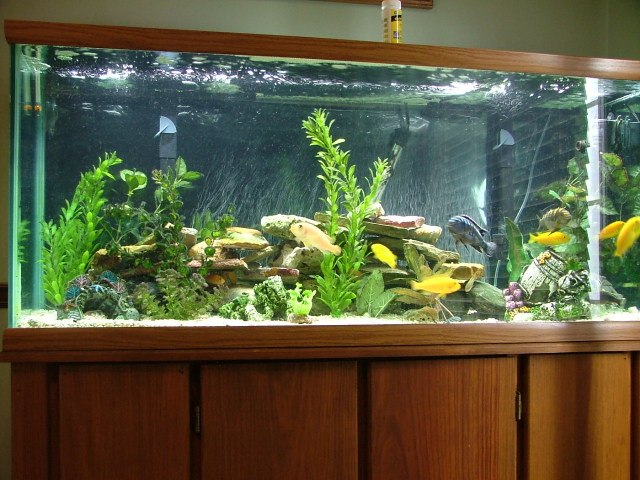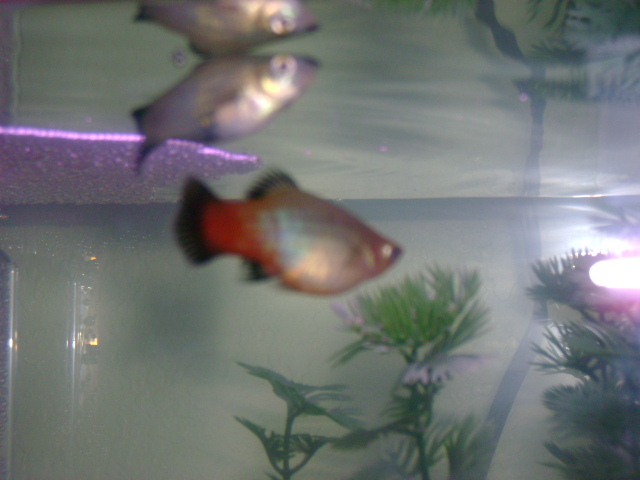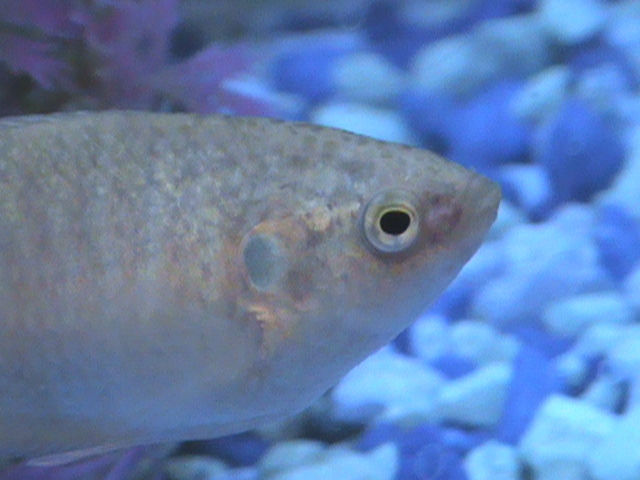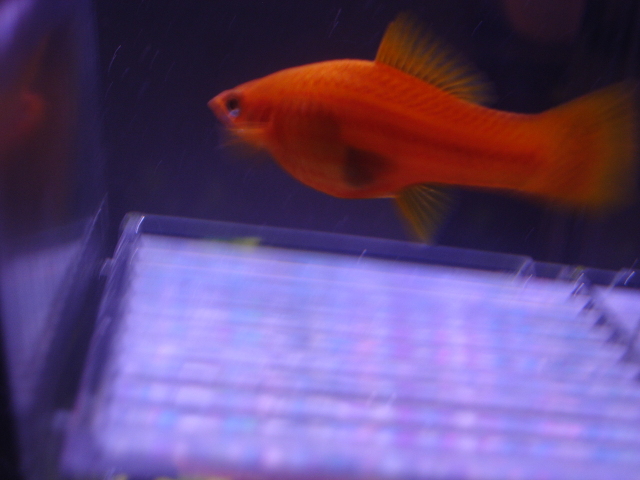QuestionQUESTION: Hello Karen, I have had experience with fish for over 5 years but have recently experienced a major problem which has baffled me. I have two albino cory catfish and read on several site that they liked sand substrate, so I changed my tank over to it. Soon I found myself battling a major problem. I suddenly found white fuzzy stuff all over the entire tank, from the bottom, to the walls, to the decor. I cleaned it and it came back, so I cleaned it again and it still came back. During this time I had my two little catfish in a hospital tank to not stress them. Well, it occured to me that the sand migh be the problem, could the sand have cause the white fuzzy stuff and if so what is it? It was an even film all over with a few white balls. I just completley cleaned the tank and competely removed the sand and replaced it with regular gravel. I am waiting to see if it works, but until then I would appreciate your help. Also, can freshwater shrimp live with cory catfish? I love my little catfish and dont want anything to happen to them, but I would like to assist the catfish with some extra cleaning power, either for algae or just overall maintainance and filtering. If the shrimp can work with the catfish, which kinds should I get and what would they do for my tank? I have a 30 gallon. Thanks very much.
ANSWER: Dear Rachel,
The only white fuzzy stuff I know about is when leftover food settles in the aquarium, there is a fungus that can develop and cover it. However I find this very unlikely since I highly doubt you have leftover food in your aquarium and certainly never to the extent that it should cover the entire bottom all the way to the walls and decor.
I think I'll have to agree with you that the sand, although thoroughly enjoyed by corydoras catfish, may have had 'something' in it like a fungus or mold when you bought it to begin with. What kind of sand did you use? If it was from a home improvement store or garden center it could have gotten moisture or fungus spores or something else contaminating it.
Usually sand it quite safe and as long as it's well-rinsed it shouldn't cause too much of a problem. Most aquarists have excellent luck with the 'play sand' sold at garden centers but things can always happen.
Feel free to get back to me on this. I bet with the gravel in there now you should have no problems anymore, I'm pretty sure you wont have the fungus again.
I hope this helps!
Happy fishkeeping!
Karen~
-------------I'M SORRY!-----------
I can't believe I failed to provide you with the info about the Shrimp and the Cory catfish together! I read thoroughly read your letter but somehow my mind was focused on the white fungus-like stuff issues. And I had already sent this letter much earlier today before remembering about the shrimp questions you asked...
There are many species of freshwater shrimp suitable for aquariums but unfortunately not all of them are available in most petstores. The most frequent species available around here for example are- Ghost shrimp (old standby) and occasionally Bamboo Shrimp. But you never see the lovely Amano Shrimp or Cherry shrimp and never the other beautiful species. Look here at this link ( highlight the links and then copy and paste into your search bar) to see some beautiful pictures and bizarre shrimp you can have for aquariums as well as info-
"http://azgardens.com/shrimpfactory.php"
Also visit-
"http://www.petshrimp.com/"
Usually freshwater shrimp can coexist and live peacefully with such docile fish as Corydoras. Cories rarely if ever bother anybody and the most cories would do towards the shrimp is sneak some of their food away! You'll have to be sure your little shrimp are getting their fair share of food. Most of the time, for the sake of the Shrimp's welfare many sources say it's best not to keep shrimp with fish. Due to the fact that all shrimp molt their shell every once in a while and before their new shell hardens they are very vulnerable for the first day or two as their new shell hardens. The shrimp usually stay hidden, and providing them with a good hiding place or two will help keep them safe. The next reason is for food competition, you can use sinking foods for most shrimp but if you have bold eaters in your tank, (which you don't currently) the shrimp won't fare very well. Flake or pellet food works well for shrimp and if you can offer variety, that's even better!
But still many aquarists keep shrimp with fish. I believe the key is to stick with only very peaceful small species, like the smaller tetras or rasboras.
I really hope this helps!
I'm sorry for forgetting about answering your second question, I wish you the best with your fishkeeping and check out some of those websites i've listed, they provide really good info on shrimp.
Karen~
---------- FOLLOW-UP ----------
QUESTION: Thank you very much for the information. I have had a difficult time finding anyone who actually knows what they are saying, especially in the actual fish stores! To answer what you asked in the first reply, I had gotten the onyx sand made for aquariums. I have recently gone back to the place where I got it from and realized they store in under the fish tanks and I aso noticed that the bags remaining had humidity in them, that probably was the problem. The bags probly began growing fungus or something. My tank has been cleaned and the gravel replaced for two full days and I do not yet see any of the old white stuff. The second time I cleaned it, within hours the white stuff was back so the fact that it has not returned in two days is a good sign. Thanks also about the shrimp undate, no worries about the re-post I appreciate you actually caring enough to get back to me about it. The more I read about the shrimp the more I think I shouldn't get any while I have the little corys. I dont want to stress them nor do I want the shrimp to be left without food, due to the great job the corys do at cleaning. I have one more question, I want to eventually add more fish, once I know the white stuff is gone, but am not sure what to get. I want something colorful, active, and overall fun but also do not want the fish to mess with the corys any. I am fascinated with Koi but am not sure whether I can house a little one in the tank of only 30 gallons. I am going to get a bigger tank next year, so my question is can I keep small baby Kois in the 30 gallon for a year or will they get too big or will they be unhappy? Also, if I can, how many is the max I should get? If you think I shouldnt get Kois for a 30 gallon tank, eventually turning into a 50 or more gallon, then what type of beautiful fish would you suggest (colorful, active, and peaceful)? Thanks so much for the time you take to answer my questions, they have helped me tremendously. Thanks!
AnswerHi Rachel, you're welcome!
I think we are certainly right about the sand having all that humidy in it that caused likely had the fungus spores inside. Sorry about your bad luck. These things can happen sometimes.
Yes, actually it may be best if you want to keep shrimp is to devote a tank just for them. Like a 10gallon works extremely well. Many people have a Shrimp-only tank decorated with real moss balls and aquatic plants where the shrimp show up very well against the greenery and they themselves appreciate the cover and food sources plants provide.
The deal about the Koi is they unfortunately really aren't suitable for aquariums and are best kept out in a very large, well-filtered pond where they can thrive. Not to say it's impossible to keep koi in aquariums, the troulbe is, they will be very fast and eager eaters and I doubt your little cories would get a chance say if you were to have a couple of Koi in your tank.
Koi can easily grow three feet if well-cared for and as you know they would need an immense aquarium to hold just a couple at this size. Even two-foot Koi would need an aquarium that is wide enough from front to back for them to turn and this would mean many hundred gallons, if not close to a thousand. Ponds are the best way to go with Koi. I love these beautiful fish too!
Is it possible you could have an alternative to Koi? Such as the beautiful goldfish varieties available? I know goldfish might be considered too beginner-ish or too basic but I must admit, well-cared for goldfish (whether fancy or the regular common or comet varieties) can display such brilliant color that can sometimes even outdo a lot of other freshwater fish. Not to mention goldfish are highly owner-responsive. Goldfish like the fancy varieties of say, Fantail, Orandas, or Ryukins can live just fine in a 30gallon for a good while. As long as you keep up with water changes you could likely have 3-4 goldfish in there. And this would be an especially good number since you are planning on upgrading to a 50gallon which is just perfect for Goldfish. I know that goldfish are considered coldwater and Cories are considered tropical, but the truth is, cories can do great at the average temperature that goldfish live at. Unless you keep your house very cold both of these fish can thrive without a heater but if you must run a heater, no harm will come to the goldfish if the temperature is in the middle 70's F.
Common and Comet goldfish are very beauitful especially the 'Sarasa' comet which is has a koi-like pattern of orange and white on it's body. These goldfish can grow to be pretty large somewhere along the lines of 8-9 inches if well-cared for but common goldfish are frequently seen at almost 12 inches!
Another factor with Koi and goldfish is their waste production or the amount of Bioload they produce which is very, very high. More so than other aquarium fish. This means excellent powerful filtration and frequent very large water changes. Something else that could be a problem with Koi or Goldfish would be that Goldfish can be big competetors of food and the cories probably won't have much of a chance with a few big old goldfish swimming with them.
Again, like with Koi, goldfish are really best suited to have an aquarium devoted just for them.
But now if you avoided goldfish and Koi, you could simply have a community tank with a variety of several species of fish. There are many fish that get along well with Cory catfish such as, all livebearing fish such as Swordtails, guppies, or platies, Angelfish, and most all species of the bigger tetras like Black skirts, Serpae tetras, or Silver tips, head and tail-light ect.. And of course the smaller tetras like Neons, Cardinals, Glow-lights, Lemons, Black phantom tetras, Red-nose tetras and more. And also the lovely Harlequin Rasboras and all Danios like the Zebra, Pearl, Leopard and longfin as well as the Giant Danio. All these fish are active, look and behave better in groups of 6 or more so remember this with all schooling fish.
~I think the first thing I'd do is get your current two Cories some more friends! However, we don't know if this aquarium is cycled yet. Since all the switching around of the new substrate could have caused a whole new cycling to start unless you have a very good biological filter running on the tank or have 1-2 established sponge filters this may not be a problem. But we certainly wouldn't want to stock a tank with more fish if it is in the middle of cycling right now. The best way to know this is to get liquid test kits for ammonia, nitrite and nitrate.
If ammonia and nitrite test for ZERO then it's safe to add a few fish per week. You probably already know this but it's well worth mentioned just in case.
Cories are very active and much more playful when they have a group of 6 individuals. You can feel free to mix different species of cories together but they really enjoy having a small group of their own species. You could add more Albino Cories if you like, or you could add some of the original colored of the cories. The most common species of cory that is sold as albino most around here is the 'Green' Cory or sometimes called Bronze Cory. Or you can do excellent with making up your school of cories as for example, "3 Albinos and 3 black spotted" or "Three albinos and three green cories" or just 6 Albino Cories. It's whatever you want. Usually mixed species of cory will swim together as a group but then they also like to seperate themselves into their own species-group on occasion. Cory catfish are so much fun!
I'm not sure what you'd exactly prefer with stocking your 30gallon with fish. But I think having a community tank consisting of 1-2 schools of small peaceful fish, 1-2 fish that are your main "Show fish" or fish that stand out from the rest, and then your Corydoras as you bottom dwellers and perhaps maybe another bottom feeder like Ancistrus catfish (also known as the Bristlenose pleco) I love these catfish, they won't bother anyone, do a good job at cleaning algae, are easy to care for, and never grow past say 4 inches unlike their cousin the common pleco which easily grows to 10-12 inches.
I think a setup like this for your 30gallon would be great-
8- Harlequin Rasboras
6-Lemon Tetras
1-2 Dwarf Gouramis (your 'show' fish)
6 Cory catfish
1 Bristlenose pleco
OR a very colorful and active mix could be made up of-
1 male and 3 Female Swordtails (any color variety)
1 male and 3-4 female Platies (any color of course)
1-2 Dwarf Gouramis OR
1-2 Angelfish
6 Corydoras
It's best to keep only 1 male of any livebearer in a tank if it is to also house females. Male swordtails and platies can be aggressive towards females sometimes and if there are too few females, he may single out one and bully her mercilessly. An alternative could be just all females which works out fine but with the swordtails, females of course don't have swords like the males so if you like the swordtail male, just remember to have one male and several females. Usually male swordtails will fight. Swordtails and platies will also crossbreed but this isn't much of a concern. However, one problem that can come with livebearers is an overpopulation due to too many fry. Female livebearers can drop dozens of fry about once a month. You can take your extra fish to a reliable petstore ideally a locally-owned one. Or if you don't want to deal with the extra babies all-together an all-natural way to deal with the many babies is to have other fish in the aquarium that will happily gobble up fry almost as soon as they are born. I know this may sound cruel but in nature you can bet this happens all the time. Angelfish are prime fry-eaters but most other fish are too. Most larger tetras and similarly sized fish will be good population control. Contrary to what most sources claim, many female livebearers do not eat their own fry. But sometimes this does happen.
You could also have a tank full of male guppies, but no females. Or if you'd like females use the same ratio above. Guppies are so active that sometime's it works out best to have 5 females to 1 male. Or just have all males which tends to be easier and you get more color in the long run.
According to my favorite fish book "The simple guide to freshwater aquariums by David E. Boruchowitz" he has listed some reliable tank stocking ideas. Here they are in the simplified form ((the first number given is the amount of fish you have for a 29 gallon, the second is the number of fish for a 50gallon)
"The typical community"
this setup provides a variety of easy to care for and interesting fish that are easily found at your local petstore. This setup ignores any specific "Biotope" as the fish have all originated from many parts of the world, however they all should be very compatable.
* Platies (3/5)
* Danios (8/8) provide non-stop action, plus metallic iridescence. You can chose from the Zebra danio, pearl, leopard or for the larger tank (50gal or larger) Giant danios fit well. For the smaller danios, you could have for example 8 Zebra danios and 8 Leopard danios.
*Lemon tetras (6/6) these fish are often dull in stores and ignored, but once in an established tank, they color up and live up to their name, with lemony yellow body that is slightly trasnparent, a pretty half-red eye and a bright yellow bottom fin edged boldly in black.
* Serpae tetras (0/6)
* Cory cats (4/6)
-this completes your 'typical' community-
There are also 'biotope' stocking schemes where the tank is stocked with fish from one general area of the world. Southeast Asia provides many beautiful and interesting aquarium fish and is one of my most favorites it's stocking scheme goes like this-
* White Cloud Mountain minnow (6/10) These are a delightful species, both colorful and hardy and are a very peaceful, active fish
* Gold Barbs (6-8)
* Harlequin Rasboras (8-15)
Both the colors and iridescences of these fish constrast from eachother as well as the behavior traits, with the boldness of the barbs to the more docile and retiring Rasboras
* 1 pair of Dwarf gouramis completes this grouping. While most people want males only, females have a subtle beauty of their own and her silverly color contrasts nicely with the male's red and blue florescent striping.
*In the larger tank (50gal) you can use two pairs of Dwarf Gouramis or one pair of Dwarfs and one pair of Honey Gouramis which are a different species and not the 'honey' variety of the dwarf. For reference Dwarf Gouramis scientific name is Colisa Lalia. But the true Honey Gourami is Colisa chuna.
----The gouramis completes this grouping and makes for a wonderful colorful, and active display of small peaceful fish. -----
"Fish that are a bit larger"
These are fish that are a bit larger than your usual community fish but this also means fewer fish, however, a very nice collection can be assembled to provide color and action...
* Blue Gourami (1 pair/2 pairs)
* Swordtails (2-4)
* Rosy Barbs (5-8)
--------------------
Then there are the tetras....
"A Tetrad of Tetras"
Tetras are among the most popular aquariums species, and this grouping creates an impressive display with four beautiful and universally available species of New World tetras. All of these fish are small, not more than 2 inches long.
* Black Neons (6-10)
* Bloodfin Tetras (6-10)
* Glowlight Tetras (6-10)
* Serpae Tetras (6-10)
This aquarium is well-stocked with fish but fortunately all these beauties have a reasonably low bio-load and I think you should still be able to have at least 2-3 more little Cories to add to your current two. But cories -can- fare just excellent when kept in pairs as yours are.
Then the lovely Livebearers....
"Livebearers only"
* Fancy Guppies (2 pairs/4 pairs)
* Swordtails (1 trio/2 trios)
* Platies (6/10)
Plenty of color and movement are provided by these brilliant livebearers, and you will get the thrill of little fry every month or so.
*Although not a livebearer, 1 Bristlenose catfish will add a little variety to this livebearers only tank. However, your Cories can fill this same role.
Then there are the little ones...
"Teeming with Tinies"
This grouping contains fish that are a little harder to find. All of them will be well worth it. The appeal of tiny fish is that with a large tank you can have so many more of them and the resulting large schools means you can see more natural behaviors.
*Spotted or Leopard Danios (6/10)
*Botai Sidthimunki (6/10) These are tiny little loaches that stay under two inches, are very active and schooling and attractively marked. They can come under the common name of "Dwarf Chain Loach"
* Dwarf Pencilfish (8/12)
* Dwarf or Pygmy Corydoras (5-7) These are tiny little miniature versions of their cousins the larger cories. They aren't as bottom bound as their larger cousins and they often school in the higher levels of the tank. Not to mention they are so darn cute! ((You could easily substitute your current cory cats))
* Pristella Tetras (6/10)
*Pygmy Gourami (1 pair/2 pairs) These delicately marked fish are about an inch and half long and very shy, so they do not fare well with most other fish. In this tank with tiny peaceful fish, they should do all right. They are beautiful, but not commonly available. If you can't get any substitute Honesy Dwarf Gouramis (Colisa Chuna) which get to about 2 inches long.
-------This completes the teeming with tinies grouping-----
I really hope this gives you some ideas on stocking your tank! Sorry if this is a little long but I just wanted to give you the best ideas I could as well as the well-trusted info from David E. Boruchowitz's book.
Best wishes with your aquarium and feel free to write with anymore concerns!
Karen~

 African Cichlids just moved tank and am paranoid!
Question
75 gal malawi tank
hello,
Ive kept fish for ye
African Cichlids just moved tank and am paranoid!
Question
75 gal malawi tank
hello,
Ive kept fish for ye
 betta tank
Question
my betta tank
hi jaymie, i have a betta tank w
betta tank
Question
my betta tank
hi jaymie, i have a betta tank w
 is my fish pregnant and was it labeled correctly in store?
Question
pregnant fish?
I bought a male and 2 females o
is my fish pregnant and was it labeled correctly in store?
Question
pregnant fish?
I bought a male and 2 females o
 jiffy!
Question
jiffy redux
first, thanx for being such a big
jiffy!
Question
jiffy redux
first, thanx for being such a big
 When will she give birth?
Questionpic 1
QUESTION: Hi,
I have a community
When will she give birth?
Questionpic 1
QUESTION: Hi,
I have a community